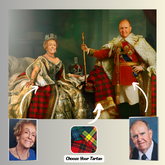-
Personalized Clan Ayrshire District Tartan Bagpipe Ornament with Custom Name – Scottish Christmas Tree Decoration PI84
Personalized Clan Ayrshire District Tartan Bagpipe Ornament with Custom Name – Scottish Christmas Tree Decoration PI84Celebrate your Scottish heritage with this unique wood & acrylic tartan ornament. Perfect as a personalized Christmas decoration or a meaningful gift for friends and relatives on special occasions...- From $19.99 USD
$25.99 USD- From $19.99 USD
- Unit price
- per
Save $6.00 -
Personalized Clan Ayrshire District Tartan Drummer Ornament with Custom Name – Scottish Christmas Tree Decoration XQ55
Personalized Clan Ayrshire District Tartan Drummer Ornament with Custom Name – Scottish Christmas Tree Decoration XQ55Celebrate your Scottish heritage with this unique wood & acrylic tartan ornament. Perfect as a personalized Christmas decoration or a meaningful gift for friends and relatives on special occasions...- From $19.99 USD
$25.99 USD- From $19.99 USD
- Unit price
- per
Save $6.00 -
Personalized Clan Ayrshire Reproduction Tartan Bagpipe Ornament with Custom Name – Scottish Christmas Tree Decoration OY80
Personalized Clan Ayrshire Reproduction Tartan Bagpipe Ornament with Custom Name – Scottish Christmas Tree Decoration OY80Celebrate your Scottish heritage with this unique wood & acrylic tartan ornament. Perfect as a personalized Christmas decoration or a meaningful gift for friends and relatives on special occasions...- From $19.99 USD
$25.99 USD- From $19.99 USD
- Unit price
- per
Save $6.00 -
Personalized Clan Ayrshire Modern Tartan Bagpipe Ornament with Custom Name – Scottish Christmas Tree Decoration DU47
Personalized Clan Ayrshire Modern Tartan Bagpipe Ornament with Custom Name – Scottish Christmas Tree Decoration DU47Celebrate your Scottish heritage with this unique wood & acrylic tartan ornament. Perfect as a personalized Christmas decoration or a meaningful gift for friends and relatives on special occasions...- From $19.99 USD
$25.99 USD- From $19.99 USD
- Unit price
- per
Save $6.00 -
Personalized Clan Ayrshire District Tartan Bagpipe Ornament with Custom Name – Scottish Christmas Tree Decoration NL65
Personalized Clan Ayrshire District Tartan Bagpipe Ornament with Custom Name – Scottish Christmas Tree Decoration NL65Celebrate your Scottish heritage with this unique wood & acrylic tartan ornament. Perfect as a personalized Christmas decoration or a meaningful gift for friends and relatives on special occasions...- From $19.99 USD
$25.99 USD- From $19.99 USD
- Unit price
- per
Save $6.00 -
Personalized Clan Ayrshire Ancient Tartan Bagpipe Ornament with Custom Name – Scottish Christmas Tree Decoration FL70
Personalized Clan Ayrshire Ancient Tartan Bagpipe Ornament with Custom Name – Scottish Christmas Tree Decoration FL70Celebrate your Scottish heritage with this unique wood & acrylic tartan ornament. Perfect as a personalized Christmas decoration or a meaningful gift for friends and relatives on special occasions...- From $19.99 USD
$25.99 USD- From $19.99 USD
- Unit price
- per
Save $6.00 -
Personalized Clan Eglinton District (Montgomery of Ayrshire) Weathered Clan Crest Tartan Santa Ornament – Custom Acrylic Christmas Decoration DP97 - Eglinton
Personalized Clan Eglinton District (Montgomery of Ayrshire) Weathered Clan Badge Tartan Ornament – Custom Acrylic Christmas Decoration DP97Celebrate your Scottish heritage with this unique wood & acrylic tartan ornament. Perfect as a personalized Christmas decoration or a meaningful gift for friends and relatives on...- From $19.99 USD
- From $19.99 USD
- Unit price
- per
-
Eglinton
-
Personalized Clan Eglinton District (Montgomery of Ayrshire) Ancient Clan Crest Tartan Santa Ornament – Custom Acrylic Christmas Decoration JZ59 - Eglinton
Personalized Clan Eglinton District (Montgomery of Ayrshire) Ancient Clan Badge Tartan Ornament – Custom Acrylic Christmas Decoration JZ59Celebrate your Scottish heritage with this unique wood & acrylic tartan ornament. Perfect as a personalized Christmas decoration or a meaningful gift for friends and relatives on...- From $19.99 USD
- From $19.99 USD
- Unit price
- per
-
Eglinton
-
Personalized Clan Eglinton District (Montgomery of Ayrshire) Modern Clan Crest Tartan Santa Ornament – Custom Acrylic Christmas Decoration IW86 - Eglinton
Personalized Clan Eglinton District (Montgomery of Ayrshire) Modern Clan Badge Tartan Ornament – Custom Acrylic Christmas Decoration IW86Celebrate your Scottish heritage with this unique wood & acrylic tartan ornament. Perfect as a personalized Christmas decoration or a meaningful gift for friends and relatives on...- From $19.99 USD
- From $19.99 USD
- Unit price
- per
-
Eglinton
-
Clan Ayrshire District Tartan Rug – Scottish Highland Carpet for Living Room, Celtic Home Decor & Scotland Gift XH18
Clan Ayrshire District Tartan Rug – Scottish Highland Carpet for Living Room, Celtic Home Decor & Scotland Gift XH18Bring timeless Scottish charm into your home with our premium Tartan Area Rug. Designed with authentic Scottish tartan patterns, this rug is perfect for adding a...- From $58.45 USD
- From $58.45 USD
- Unit price
- per
-
Clan Ayrshire District Tartan Scotland Map Canvas “Tartan Runs Through My Veins” Wall Art KJ14
Clan Ayrshire District Tartan Scotland Map Canvas “Tartan Runs Through My Veins” Wall Art KJ14Celebrate your Scottish heritage with this striking canvas print featuring the map of Scotland filled with Ayrshire District tartan, paired with the bold phrase: “Tartan Runs Through My Veins.” Whether...- From $35.05 USD
- From $35.05 USD
- Unit price
- per
-
Personalized Clan Ayrshire District Tartan Shirt with Scotland Coat of Arms & Custom Name WE74 - Ayrshire District
Ayrshire District Tartan Shirt with Scotland Coat of Arms & Custom Name WE74Celebrate your Scottish heritage with this Ayrshire District Tartan Shirt with Scotland Coat of Arms & Custom Name WE74, featuring a bold Scotland Coat of Arms and your custom name on the...- From $39.54 USD
- From $39.54 USD
- Unit price
- per
-
Ayrshire District
-
Clan Ayrshire District Tartan Custom Face Hawaiian Shirt – Unisex Gift for Family Members, Summer Party MF20 - Ayrshire District Tartan
Clan Ayrshire District Tartan Custom Face Hawaiian Shirt – Unisex Gift for Family Members, Summer Party MF20?? Stand out with our custom face Hawaiian shirt featuring your chosen tartan pattern and up to 10 faces printed for free! Whether it's your own, your pet's,...- $42.25 USD
$59.99 USD- $42.25 USD
- Unit price
- per
Save $17.74-
Ayrshire District Tartan
-
Clan Ayrshire District Tartan Flat Cap TZ34 - Clan Ayrshire District Tartan
Clan Ayrshire District Tartan Flat Cap TZ34Elevate Your Heritage: The Authentic Tartan Jeff Cap Step into a legacy of timeless style and comfort with our Authentic Tartan Flat Cap. Crafted for the discerning American who cherishes their Scottish roots and appreciates classic elegance, this isn’t...- From $33.85 USD
$45.59 USD- From $33.85 USD
- Unit price
- per
Save $11.74-
Clan Ayrshire District Tartan
-
Clan Eglinton District (Montgomery of Ayrshire) Weathered Tartan Crest Badge Aloha Hawaiian Shirt Tropical Old Style BH93 - Eglinton District (Montgomery of Ayrshire) Weathered Tartan
Eglinton District (Montgomery of Ayrshire) Weathered Tartan Clan Crest Badge Aloha Hawaiian Shirt Tropical Old Style BH93 These Hawaiian shirts and shorts are suitable for hot summer days or beach trips with your friends, family, and loved ones. This is an excellent gift, vacation...- $43.25 USD
- $43.25 USD
- Unit price
- per
-
Eglinton District (Montgomery of Ayrshire) Weathered Tartan
-
Clan Eglinton District (Montgomery of Ayrshire) Modern Tartan Crest Badge Aloha Hawaiian Shirt Tropical Old Style HL52 - Eglinton District (Montgomery of Ayrshire) Modern Tartan
Eglinton District (Montgomery of Ayrshire) Modern Tartan Clan Crest Badge Aloha Hawaiian Shirt Tropical Old Style HL52 These Hawaiian shirts and shorts are suitable for hot summer days or beach trips with your friends, family, and loved ones. This is an excellent gift, vacation...- $43.25 USD
- $43.25 USD
- Unit price
- per
-
Eglinton District (Montgomery of Ayrshire) Modern Tartan
-
Eglinton District (Montgomery of Ayrshire) Ancient Tartan Clan Crest Badge Aloha Hawaiian Shirt Tropical Old Style QV88 - Eglinton District (Montgomery of Ayrshire) Ancient Tartan
Eglinton District (Montgomery of Ayrshire) Ancient Tartan Clan Crest Badge Aloha Hawaiian Shirt Tropical Old Style QV88 These Hawaiian shirts and shorts are suitable for hot summer days or beach trips with your friends, family, and loved ones. This is an excellent gift, vacation...- $43.25 USD
- $43.25 USD
- Unit price
- per
-
Eglinton District (Montgomery of Ayrshire) Ancient Tartan
-
Clan Ayrshire District Tartan Christmas Ugly Sweater GG65 - Ayrshire District Tartan
Clan Ayrshire District Tartan Christmas Ugly Sweater GG65 SIZE CHART- From $64.25 USD
- From $64.25 USD
- Unit price
- per
-
Ayrshire District Tartan
-
Clan Ayrshire District "Merry Christmas" Tartan Acrylic Ornament FP20 - Ayrshire District Tartan
Clan Ayrshire District 'Merry Christmas' Tartan Acrylic Ornament FP20 “Decorating the house” may be one of the most exciting tasks jotted down on your to-do list when the holiday season approaches. Yet, since shabby, dull-looking pieces of decor infest the marketplace, finding real gems...- From $21.25 USD
- From $21.25 USD
- Unit price
- per
-
Ayrshire District Tartan
-
Clan Ayrshire District Tartan Gnome Heart Ceramic Ornament RH76 - Ayrshire District Tartan Gnome
Clan Ayrshire District Tartan Gnome Heart Ceramic Ornament RH76 One of the best things about Christmas is that it gives you an excuse to dress up your home with all of the lovely ornaments we associate with the holiday season. With so many different...- From $19.25 USD
- From $19.25 USD
- Unit price
- per
-
Ayrshire District Tartan Gnome
Ex: Your Tartan + Product
Popular Products
Turn Me Royal Personalized Portrait from Your Photo, Custom Tartan. Custom Canvas Wall Art as Gift for Men
- From $32.45 USD
- From $32.45 USD
- Unit price
- / per
Royalty Couple Personalized Portrait from Your Photo, Custom Tartan. Custom Canvas Wall Art
- From $47.45 USD
- From $47.45 USD
- Unit price
- / per
The Queen Personalized Portrait from Your Photo, Custom Tartan. Custom Canvas Wall Art as Gift for Women
- From $32.45 USD
- From $32.45 USD
- Unit price
- / per
Which Clan Are You From?
List Of Tartan
-
Clan A
- Abercrombie Tartan
- Aberdeen Tartan
- Abernethy Tartan
- Adair Tartan
- Adam Tartan
- Ayrshire Tartan
- Agnew Tartan
- Aikenhead Tartan
- Ainslie Tartan
- Aiton Tartan
- Allan Tartan
- Alexander Tartan
- Allardice Tartan
- Allison Tartan
- Anderson Tartan
- Angus Tartan
- Anstruther Tartan
- Arbuthnot Tartan
- Armstrong Tartan
- Arnott Tartan
- Auchinleck Tartan
- Ayrshire Tartan
-
Clan B
- Baillie Tartan
- Bain Tartan
- Baird Tartan
- Balfour Tartan
- Bannatyne Tartan
- Bannerman Tartan
- Barclay Tartan
- Baxter Tartan
- Beaton Tartan
- Bell Tartan
- Belshes Tartan
- Bethune Tartan
- Beveridge Tartan
- Binning Tartan
- Bisset Tartan
- Blackadder Tartan
- Blackstock Tartan
- Black Watch Tartan
- Blair Tartan
- Blane Tartan
- Blyth Tartan
- Borthwick Tartan
- Boswell Tartan
- Bowie Tartan
- Boyd Tartan
- Boyle Tartan
- Brisbane Tartan
- Brodie Tartan
- Brown/ Broun Tartan
- Bruce Tartan
- Buccleuch Tartan
- Buchan Tartan
- Buchanan Tartan
- Burnett Tartan
- Burns Tartan
- Butter Tartan
- Byres Tartan
-
Clan C
- Cairns Tartan
- Calder Tartan
- Callander Tartan
- Cameron Tartan
- Campbell Tartan
- Campbell of Breadalbane Tartan
- Campbell of Cawdor Tartan
- Carmichael Tartan
- Carnegie Tartan
- Carruthers Tartan
- Cathcart Tartan
- Chalmers Tartan
- Charteris Tartan
- Chattan Tartan
- Cheyne Tartan
- Chisholm Tartan
- Christie Tartan
- Clark Tartan
- Clelland Tartan
- Clephan Tartan
- Clergy Tartan
- Cochrane Tartan
- Cockburn Tartan
- Colquhoun Tartan
- Colville Tartan
- Cooper Tartan
- Couper Tartan
- Craig Tartan
- Cranstoun Tartan
- Crawford Tartan
- Crichton Tartan
- Crief District Tartan
- Crosbie Tartan
- Cumming Tartan
- Cunningham Tartan
- Currie Tartan
- Clan D
- Clan E
- Clan F
- Clan G
- Clan H
- Clan I
- Clan J
- Clan K
- Clan L
-
Clan M
- Maitland Tartan
- Malcolm Tartan
- Mar Tartan
- Marjoribanks Tartan
- Maxtone Tartan
- Matheson Tartan
- Maule Tartan
- Maxwell Tartan
- Meldrum Tartan
- Melville Tartan
- Menzies Tartan
- Mercer Tartan
- Middleton Tartan
- Moffat Tartan
- Moncrieffe Tartan
- Montgomery Tartan
- Monypenny Tartan
- Moncreiffe Tartan
- Monteith Tartan
- Morrison Tartan
- Mouat Tartan
- Moubray Tartan
- Mow Tartan
- Muir_More Tartan
- Muirhead Tartan
- Munro Tartan
- Murray Tartan
- Murray of Atholl Tartan
-
Clan Mc/Mac
- MacAlister Tartan
- MacArthur Tartan
- MacAlpine Tartan
- MacAulay Tartan
- MacBain Tartan
- MacBean Tartan
- MacBeth Tartan
- MacCallum Tartan
- MacCraig Tartan
- MacColl Tartan
- MacCorquodale Tartan
- MacDiarmid Tartan
- MacDonald Tartan
- MacDonald of Clanranald Tartan
- MacDonald of Sleat Tartan
- MacDonnell of Glengarry Tartan
- MacDonnell of Keppoch Tartan
- MacDougall Tartan
- MacDowall Tartan
- MacDuff Tartan
- MacEwen_MacEwan Tartan
- MacEdward Tartan
- MacFarlane Tartan
- MacGill Tartan
- MacGillivray Tartan
- MacGregor Tartan
- MacGowan (McGowan) Tartan
- MacHardy Tartan
- MacIan Tartan
- MacInnes Tartan
- MacIntyre Tartan
- MacKay Tartan
- MacKillop Tartan
- MacKellar Tartan
- Mackinlay Tartan
- MacKenzie Tartan
- Mackie Tartan
- MacKinnon Tartan
- MacKintosh / MacIntosh Tartan
- MacLeod Tartan
- MacMillan Tartan
- MacNab Tartan
- MacNaughton Tartan
- MacNeil / MacNeill Tartan
- MacNeil of Colonsay Tartan
- MacNicol Tartan
- MacPhail Tartan
- MacPhee_MacFie Tartan
- MacPherson Tartan
- MacQuarrie Tartan
- MacQueen Tartan
- MacRae Tartan
- MacRow Tartan
- MacSporran Tartan
- MacTaggart Tartan
- MacTavish Tartan
- MacThomas Tartan
- McCorquodale Tartan
- McCulloch Tartan
- McFadzen Tartan
- McGeachie Tartan
- McIver Tartan
- McKerrell Tartan
- Clan N
- Clan O
- Clan P
- Clan R
-
Clan S
- Sandilands Tartan
- Scott Tartan
- Scrymgeour Tartan
- Selkirk Tartan
- Sempill Tartan
- Seton Tartan
- Shaw Tartan
- Shepherd Tartan
- Sinclair Tartan
- Skene Tartan
- Skirving Tartan
- Smith Tartan
- Somerville Tartan
- Spalding Tartan
- Spens Tartan
- Spottiswood Tartan
- Stevenson Tartan
- Stewart Tartan
- Stewart of Appin Tartan
- Stirling Tartan
- Strachan Tartan
- Straiton Tartan
- Strange Tartan
- Strathclyde District Tartan
- Stuart of Bute Tartan
- Sutherland Tartan
- Swinton Tartan
- Clan T
- Clan U W Y
- Request Your Clan
Clan Ayrshire (Ayrshire Tartan)
7. The Power Dynamics of Scottish Clans: Exploring Ayrshire's Prominent Clans and Historical Events
In this article, we delve into the rich history of Scottish Clans, focusing on the most prominent clans in Ayrshire.
Ayrshire, located on the southwest coast of Scotland, has been home to several influential clans throughout the centuries.
We will explore their origins, castles, and the significant historical events that have shaped the power dynamics of these Scottish Clans.
8. Clan Ayrshire: Unraveling the Essence of Prominent Clans
8.1 The Campbell Clan: Guardians of Ayrshire
The Campbell clan, one of the most powerful clans in Ayrshire, has played a significant role in Scottish history.
With their ancestral seat at Inveraray Castle, they have been known as the "Guardians of Ayrshire." The Campbells have a colorful past that includes alliances, feuds, and moments of power.
8.1.1 The Origins of the Campbell Clan
The Campbell clan traces its origins to the Gaelic family "Clan O'Duine," which means "children of the Hill." They first gained prominence during the 11th century when they became allies of the Scottish kings.
Over the years, their influence and power grew, as they acquired extensive lands and castles in Ayrshire.
8.1.2 Inveraray Castle: An Emblem of Campbell Power
Inveraray Castle, located on the banks of Loch Fyne, stands as a grand testament to the Campbell clan's power and influence in Ayrshire.
This iconic castle, designed by renowned architect Sir John Vanbrugh in the 18th century, boasts stunning architecture and majestic surroundings.
It serves as the ancestral home of the Dukes of Argyll, the heads of the Campbell clan, and remains a popular tourist attraction to this day.
8.1.3 Historical Significance: Campbell Clan's Role in Scottish Politics
The Campbell clan played a crucial role in Scottish politics, often aligning themselves with the ruling monarchy.
They were instrumental in various conflicts and battles that shaped Scottish history, such as the Wars of Independence and the Jacobite uprisings.
Their allegiance to the Crown sometimes led to conflicts with other clans, creating a complex web of power dynamics.
8.2 The Boyd Clan: A Legacy of Power and Intrigue
Another prominent clan in Ayrshire is the Boyd clan. Known for their political astuteness and wealth, the Boyds had a significant impact on Scottish history.
8.2.1 The Rise of the Boyd Clan
The Boyd clan rose to power in the 14th century. Their rise to prominence was facilitated by their alliances with other influential families in Ayrshire and beyond.
The Boyds acquired vast estates and powerful positions, solidifying their status as one of the leading clans in the region.
8.2.2 Dean Castle: A Testament to Boyd Power
Dean Castle, located near Kilmarnock in Ayrshire, stands as a remarkable symbol of Boyd power and influence.
This well-preserved medieval castle showcases the grandeur and architectural prowess of the Boyd clan. Its rich history and magnificent grounds make it a popular tourist destination.
8.2.3 Boyd Clan's Involvement in Scottish Affairs
The Boyds made their mark in Scottish affairs through their involvement in politics, finance, and society.
They held influential positions, serving as advisors to Scottish kings and participating in diplomatic missions.
However, their wealth and power also made them targets of rival clans and factions, leading to struggles and conspiracies.
9. Historical Events: Shaping the Power Dynamics of Scottish Clans
9.1 Battle of Carham (1018): Consolidating Scottish Borders
In 1018, King Malcolm II of Scotland achieved a decisive victory at the Battle of Carham against the Northern English.
This triumph defined the borders of the Kingdom of Scotland, closely resembling the current boundaries.
Although subsequent attempts by the Scots to capture lands in Northern England were made, they were unable to retain control.
9.2 Battle of Largs (1263): Defeating the Norse Invaders
On October 1st, 1263, King Alexander III of Scotland triumphed over the Norwegian King Haakon at the Battle of Largs.
This battle marked the end of Viking raids on the Western Isles and the west coast of Scotland, effectively driving the Vikings out of Scotland for good.
9.3 Edwardian Conquest and Scottish Resistance
The death of King Alexander III of Scotland in 1286, along with the tragic demise of his sole heir, Princess Margaret, led to Edward I of England, also known as Longshanks, attempting to gain control over Scotland.
Scottish nobles chose John Balliol as their king in 1292, but his attempts to remove the English from Scotland were unsuccessful.
Balliol's subsequent imprisonment and the rise of William Wallace as the Guardian of Scotland fueled the resistance against English rule.
9.4 Battle of Bannockburn (1314): Bruce's Triumph
On June 23rd, 1314, a Scottish army led by Robert the Bruce confronted an English army led by King Edward II at Bannockburn, Stirlingshire.
Bruce emerged victorious from this pivotal battle, forcing the English to retreat and eventually withdraw from Scotland.
This historic triumph marked a turning point in the struggle for Scottish independence.
9.5 The Stuart Dynasty: Kings of Scotland and England
The death of Bruce's son, David II, in 1371 without leaving an heir led to the crowning of Robert II (Stewart), the grandson of Robert the Bruce.
This marked the beginning of the Stuart dynasty, which went on to rule over Scotland and England.
The Stuarts faced various challenges, including internal conflicts, religious disputes, and clashes with rival claimants to the throne.
9.6 Battle of Culloden Moor (1746): The Decline of Jacobite Rebellion
The final battle of the Jacobite uprisings, the Battle of Culloden Moor, took place on April 16th, 1746.
This battle near Inverness resulted in the defeat of the Jacobites and the flight of Bonnie Prince Charlie to France.
It marked the decline of the Jacobite rebellion and the diminishing power of the clans.
9.7 The House of Hanover and the House of Windsor
The death of Queen Anne, a Protestant Stuart, in 1714 without leaving an heir, led to George I of the House of Hanover ascending to the throne of Great Britain.
This succession was fueled by political and religious tensions, as the Catholic Stuarts were seen as a threat. George I's reign marked the beginning of the House of Hanover.
Later, amidst World War I, King George V changed the name of the royal house to the House of Windsor, distancing the monarchy from its German connections.
10. Frequently Asked Questions (FAQs)
10.1 How did the Campbell clan rise to power in Ayrshire?
The Campbell clan rose to power through alliances with Scottish kings and the acquisition of extensive lands and castles. Their power grew over time, leading them to become known as the "Guardians of Ayrshire."
10.2 What significance does Inveraray Castle hold for the Campbell clan?
Inveraray Castle serves as the ancestral seat of the Dukes of Argyll, heads of the Campbell clan. It stands as a symbol of Campbell power, showcasing remarkable architecture and attracting visitors from around the world.
10.3 What role did the Boyd clan play in Scottish history?
The Boyd clan had significant influence in Scottish politics, finance, and society. They held powerful positions and were known for their political astuteness and wealth.
10.4 How did the Battle of Bannockburn shape Scottish history?
The Battle of Bannockburn, won by Robert the Bruce, was a crucial event in the struggle for Scottish independence. It forced the English to retreat and marked a turning point in the power dynamics between Scotland and England.
10.5 Who were the key players in the Jacobite uprisings?
The Jacobite uprisings involved various clans and factions supporting the claims of the Catholic Stuarts to the throne. Bonnie Prince Charlie, also known as Charles Edward Stuart, played a central role in these uprisings.
11. Conclusion
The power dynamics of Scottish clans in Ayrshire have been influenced by significant historical events and the rise and fall of prominent families.
The Campbell clan and the Boyd clan are just two examples of the clans that have left their mark on Scottish history.
From battles for independence to political alliances and conflicts, these clans have shaped the course of Scotland's past. Today, their legacies continue to hold a place in the hearts and minds of the Scottish people.
- Choosing a selection results in a full page refresh.
















































